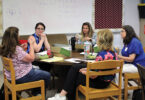
Becky Davis, one of three retreat team leaders at Prairie Star Ranch, talks with eighth graders from St. Benedict Catholic School in Atchison during their Environmental Stewardship Retreat.
by Moira Cullings
moira.cullings@theleaven.org
WILLIAMSBURG — Frogs were jumping everywhere — on people’s heads, arms and shoulders.
But the students of St. Benedict School in Atchison didn’t mind.
The plague of jumping frogs, in fact, was just one of the highlights of the Environmental Stewardship Retreat that the eighth-graders attended at Prairie Star Ranch in Williamsburg on April 13 and 14.
The retreat, inspired by the teachings of Pope Benedict XVI and Pope Francis, was packed with hands-on learning experiences designed to teach the students about the beauty and purpose of the created world.
Jumping into the oasis
“When the kids first arrived, we wanted to get them out into creation as soon as we could, to open their eyes and help them observe and explore the created world,” said Gregory Wellnitz, director of Prairie Star Ranch.
“We wanted to get them out of the fast pace of their [regular] lives and move them toward [becoming] discoverers, explorers of the created world,” he continued.
That desire was a key component of the overall reason for this retreat.
“Our mission for the program is ‘to capture the attention of the inquisitive mind, bringing to it affection for this planet and all of the life that God created for the sake of love,’” said Becky Davis, one of three retreat team leaders.
“Our main purpose was to provide an opportunity for the reigniting of a spark within each of the students at the mystery and awesomeness of God’s creation, from the littlest plant to the person sitting next to them,” she added.
What better way to do this than through immersing the kids in nature?
With activities like exploration hikes, stargazing and canoeing, this retreat provided the perfect environment for the ultimate learning experience.
“We went down into the creeks, we went into the grass, we tried to get close down onto the earth and look at the bugs and creatures that are crawling around,” said Wellnitz.
At each location, the retreatants gained a deeper understanding of how the natural world operates, what human dominion over the earth entails, how to manage away from civilization and, most importantly, how to care for the environment.
“Care for the environment makes up a big part of the body of [Pope] Benedict’s teaching,” said Wellnitz. “John Paul II talks on it at length, and now, with Pope Francis and ‘Laudato Si’,’ it seemed like a call to arms.”
“This is a call to understand what it means to truly care for creation as it was intended by the Creator — to give [students] a lens through which to view creation as a Christian,” he continued.
The variety of ecosystems at the ranch helped retreatants grasp these concepts in a tangible way.
“They were naming, they were identifying, they were having fun with creation,” said Wellnitz. “And that gave us a great teaching tool.”
Another perk the students received was a much-needed break from the chaos of everyday life.
“There is a longing to slow down and experience God in and through his creation embedded deep within each human heart,” said Davis. “But it is often drowned out by the noise of everyday life.”
“During the retreat, we are able to give students time to slow down and intentionally encounter the Lord in and through his creation.”
A classroom without bounds
This was the students’ first overnight retreat, said St. Benedict principal Diane Liebsch, but she thought it was definitely worth the extra effort.
“Being outdoors in the spring and having the time to savor nature is probably a rare opportunity for many of our students, who are active in outdoor sports,” she said. “But studying the grass, the creek, the night sky — what wonderful ‘classrooms’ they experienced!”
The leaders noticed how receptive the students were to each activity in which they participated.
“[The students] responded positively to looking closely at nature and weren’t afraid to get dirty and explore,” said Katie Friess, one of the retreat team leaders.
“I think they were happily surprised to have so much freedom to explore,” she added.
One of the students’ favorite activities was a wilderness survival hike, in which each team built their own campfires, cooked dinner and built shelters, said Friess.
“It was very hands-on, and they enthusiastically dove into these constructive and purposeful activities,” she said.
“The students also really loved the nighttime activities,” said Tori Gambino, another retreat leader. One of the most popular games, known as predator-prey, allowed the students to experience what it’s like searching for food in the wild.
Another nighttime game involved crunching Lifesaver mints with mouths open for all to see, she said.
“As the mints crush and the sugar crystals fracture, a burst of ultraviolet energy reacts with the wintergreen oil, causing a ‘spark’ that can be seen in the dark,” she said. “There were lots of laughs and excitement [with that activity].”
Once the students returned to school with these new experiences under their belts, Liebsch noticed how positively they were impacted.
“There are so many great lessons when students travel together, several hours from home, and experience prayer in the center of God’s creation in the midst of environmental lessons,” she said.
“One student popped in and said, ‘You need to take the eighth-graders to Prairie Star every year!’” said Liebsch.
“That’s a good testimony to the value of the environmental retreat experience,” she added.
But retreats like this only succeed on the heels of an incredible amount of planning and a focused, intentional approach on the part of the organizers and leaders.
“We wanted the students to be able to answer their own questions based on hands-on environmental education and adventure catechesis,” said Friess.
“However, the overarching lesson we sought to communicate throughout the retreat,” she continued, “was God’s personal love for each of them, which he reveals to us through the beauty and gift of creation.”
But that’s not the only takeaway.
“We also wanted them to have this appreciation for the order and the intricacies and the details that God put into creation,” said Wellnitz. “And how each person is intimately tied to the created order.
“Your care for the environment is intricately tied to your care for your fellow human being and your relationship with those around you.”
Through the Environmental Stewardship Retreat, the students were able to contemplate the vastness of creation and the importance of human dignity within that order, he said.
The created world around us is this great book that tells the good news that God has a plan of sheer goodness for all of the created order, said Wellnitz, and he’s working out that plan throughout time.
“And so this was an opportunity for us to unfold and open up the pages of that book,” he said.






